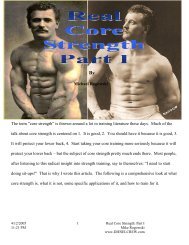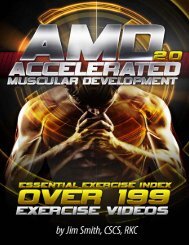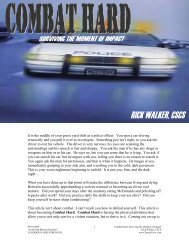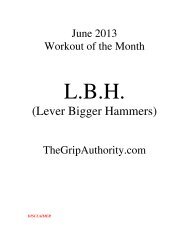Bringing Back the Shoulders - Diesel Crew
Bringing Back the Shoulders - Diesel Crew
Bringing Back the Shoulders - Diesel Crew
Create successful ePaper yourself
Turn your PDF publications into a flip-book with our unique Google optimized e-Paper software.
<strong>Bringing</strong> <strong>Back</strong> <strong>the</strong> <strong>Shoulders</strong><br />
Mike Kamal<br />
Peak performance in competition should always be <strong>the</strong> primary goal of<br />
training. The unfortunate and sometimes unavoidable consequences<br />
of sport are fatigue, breakdown and, ultimately, injury. In contact and<br />
non-contact sports, <strong>the</strong> integrity of <strong>the</strong> shoulder girdle is highly<br />
essential for performance. It is also a very vulnerable area. Injuries<br />
that occur here may become chronic and debilitating. For this reason,<br />
we cannot overlook <strong>the</strong> importance of <strong>the</strong> shoulder girdle in our<br />
training programs.<br />
To fur<strong>the</strong>r <strong>the</strong> argument for <strong>the</strong> importance of a strong, stable, and<br />
balanced shoulder girdle, I ask you this question: At <strong>the</strong> Division One<br />
level, which area of <strong>the</strong> body do you think received <strong>the</strong> most treatment<br />
during preseason, competitive season, and post season for football,<br />
and all intercollegiate sports for that matter One might guess <strong>the</strong><br />
hamstrings, ankles, or knees. Believe it or not, based on cumulative<br />
reports received from <strong>the</strong> sports medicine department of a Division<br />
One institution, athletes received significantly more treatments for <strong>the</strong><br />
shoulder than any o<strong>the</strong>r joint or muscle. It led me to brainstorming,<br />
Mike Kamal: <strong>Bringing</strong> <strong>Back</strong> <strong>the</strong> <strong>Shoulders</strong> 1<br />
www.<strong>Diesel</strong><strong>Crew</strong>.com<br />
“Achieving Beyond Potential”
eading, researching, and developing a plan of attack to <strong>the</strong> issue as<br />
presented here.<br />
Let’s now look fur<strong>the</strong>r into <strong>the</strong> problem and potential solutions for how<br />
to handle it as a professional working with athletes. These factors<br />
include strength and structural balance, mobility, and stability.<br />
Strength and Structural Balance<br />
Working with college football, I can say that it is common for an<br />
athlete to enter college being able to bench press more than <strong>the</strong>y can<br />
properly squat. Also, an athlete that some may consider very strong,<br />
such as a 300lb bench press, can not properly perform 10 body weight<br />
rack rows or pull ups. These underdeveloped and unbalanced athletes<br />
are setting <strong>the</strong>mselves up for injury. Yes, <strong>the</strong> athlete possesses<br />
horizontal pressing strength, but has no structural balance. The lack<br />
of posterior shoulder girdle strength will lead to some prominent<br />
anatomical changes. These changes include internal rotation of <strong>the</strong><br />
humerus, protraction of <strong>the</strong> scapula, and rounding of <strong>the</strong> upper back.<br />
This posture is depicted in <strong>the</strong> image below to <strong>the</strong> left. Proper<br />
posture, with a slight chin-tuck, scapula retracted and depressed<br />
(pinched back and brought down) is portrayed in <strong>the</strong> image to <strong>the</strong><br />
right.<br />
Mike Kamal: <strong>Bringing</strong> <strong>Back</strong> <strong>the</strong> <strong>Shoulders</strong> 2<br />
www.<strong>Diesel</strong><strong>Crew</strong>.com<br />
“Achieving Beyond Potential”
Poor Posture Good Posture<br />
If you have concerns with <strong>the</strong> athlete sustaining an injury or unsure of<br />
what to do from here, take into consideration structural balance within<br />
<strong>the</strong>ir training program. Employing a structurally balanced program (of<br />
push to pull exercises, if not a 2:1 ratio of pulls to pushes) will help to<br />
create balance between anterior and posterior musculature. Some<br />
great exercises that we use to develop overall posterior shoulder girdle<br />
strength and <strong>the</strong> rack row, pull ups, and dumbbell scapula rows.<br />
These three exercises are personal favorites as <strong>the</strong>y are not only great<br />
multi-joint streng<strong>the</strong>ners, but also help to teach proper scapula<br />
position: retracted and depressed.<br />
The rack row is a great exercise for building up posterior shoulder<br />
girdle strength. Start with feet elevated (advanced), or in contact with<br />
<strong>the</strong> ground (beginner). Keep <strong>the</strong> core tight, raise <strong>the</strong> hips up to create<br />
a table top position. From here, row yourself in <strong>the</strong> bar, touching <strong>the</strong><br />
bar to <strong>the</strong> lower part of <strong>the</strong> sternum. Be sure to keep <strong>the</strong> scapula<br />
retracted and depressed upon completion of a rep.<br />
Mike Kamal: <strong>Bringing</strong> <strong>Back</strong> <strong>the</strong> <strong>Shoulders</strong> 3<br />
www.<strong>Diesel</strong><strong>Crew</strong>.com<br />
“Achieving Beyond Potential”
Rack Row Start Rack Row Finish<br />
The dumbbell scapula row is actually a two part movement. The first<br />
action comes at <strong>the</strong> initiation of <strong>the</strong> movement, where <strong>the</strong> athlete will<br />
retract and depress <strong>the</strong> scapula. From here, row <strong>the</strong> dumbbell to <strong>the</strong><br />
hip, return back to <strong>the</strong> starting position, and repeat<br />
DB Scap Row Start DB Scap Row w/ retraction DB Scap Row Finish<br />
Thoracic Spine Mobility<br />
Poor posture is very evident in today’s society. The vast use of<br />
computers and video games add to this dilemma, creating <strong>the</strong> kyphotic<br />
(rounded back) posture. We, as professionals, may have exposure to<br />
<strong>the</strong> athletes for 90 minutes 2 or 3 times a week in-season, and up to 5<br />
times a week off-season. That’s not that much in <strong>the</strong> grand scheme of<br />
it all. With a great deal of work to do and always seem pressed for<br />
time, we must choose and select exercises wisely during <strong>the</strong>se training<br />
sessions. In order for us to address <strong>the</strong> thoracic spine, we must first<br />
understand it.<br />
Mike Kamal: <strong>Bringing</strong> <strong>Back</strong> <strong>the</strong> <strong>Shoulders</strong> 4<br />
www.<strong>Diesel</strong><strong>Crew</strong>.com<br />
“Achieving Beyond Potential”
The body is made of a series of stable and mobile joints. Michael<br />
Boyle described and simplified this in great detail in a recent article “A<br />
Joint by Joint Approach to Training.” The thoracic spine is a mobile<br />
joint and a lack of mobility here will assist in pain accumulation in <strong>the</strong><br />
neck and lower back.<br />
Although exercises to attain thoracic spine mobility are not very<br />
common, <strong>the</strong>re are a few very good exercises out <strong>the</strong>re. Mike<br />
Robertson and Bill Hartman have a number of great exercises detailed<br />
in <strong>the</strong>ir book “Inside-Out, The Ultimate Upper Body Warm-Up.” Below<br />
are two drills we commonly use, side lying rotations and foam rolling<br />
of <strong>the</strong> thoracic spine. To perform <strong>the</strong> side lying rotation, place a small<br />
medicine ball underneath <strong>the</strong> left knee and keep pressure on it.<br />
Extend <strong>the</strong> right arm 45 degrees to <strong>the</strong> body, reaching as far out as<br />
possible. With <strong>the</strong> left arm, reach out as far as you can, and, in a<br />
rainbow like motion, attempt to bring it to <strong>the</strong> ground; focus on <strong>the</strong><br />
rotation of your upper back.<br />
Side Lying Rotation Start<br />
Side Lying Rotation Finish<br />
Although not a mobility drill, foam rolling will aid in <strong>the</strong> process<br />
correcting ones posture by addressing <strong>the</strong> soft tissue in this area. To<br />
really expose <strong>the</strong> musculature here, cross <strong>the</strong> arms so as to get <strong>the</strong><br />
shoulders blades out of <strong>the</strong> way.<br />
Mike Kamal: <strong>Bringing</strong> <strong>Back</strong> <strong>the</strong> <strong>Shoulders</strong> 5<br />
www.<strong>Diesel</strong><strong>Crew</strong>.com<br />
“Achieving Beyond Potential”
Foam Roll Thoracic Spine<br />
Scapula Stability<br />
As described earlier, posterior shoulder girdle is extremely important<br />
in shoulder health. If strength and stabilization are lacking in <strong>the</strong><br />
scapulo-thoracic area, a common side effect will be shoulder pain,<br />
namely rotator cuff tendonitis. This is a vicious cycle, stemming from<br />
<strong>the</strong> vast amounts of pressing and limited pulling exercises. In a<br />
proper anatomical position, as previously mentioned, <strong>the</strong> scapula<br />
should be retracted (pinched toge<strong>the</strong>r) and depressed (brought down).<br />
This is <strong>the</strong> position that we constantly cue and seek to attain<br />
throughout <strong>the</strong> exercises performed. The rhomboids and lower traps<br />
are two main scapula retractors which need to be streng<strong>the</strong>ned in<br />
order to enhance stability. Two exercises that we very frequently use<br />
to streng<strong>the</strong>n <strong>the</strong>se muscles and emphasize proper scapula position<br />
are <strong>the</strong> high rope row and prone T’s. The high rope row, similar to a<br />
face pull, utilizes an athlete’s body weight as resistance. To perform<br />
<strong>the</strong> exercise, <strong>the</strong> athletes must row <strong>the</strong>mselves, retracting and<br />
depressing <strong>the</strong> scapula. The prone T’s, also known as horizontal<br />
abduction, requires <strong>the</strong> athlete to externally (thumbs up) or internally<br />
(thumbs down) rotate and again, retract and depress <strong>the</strong> scapula.<br />
Mike Kamal: <strong>Bringing</strong> <strong>Back</strong> <strong>the</strong> <strong>Shoulders</strong> 6<br />
www.<strong>Diesel</strong><strong>Crew</strong>.com<br />
“Achieving Beyond Potential”
High Rope Row Finish Prone T Finish<br />
I would also like to note an extremely important and commonly<br />
overlooked scapula stabilizer called <strong>the</strong> serratus anterior. Located on<br />
<strong>the</strong> anterior surface of <strong>the</strong> body, at first glance, may not seem to play<br />
<strong>the</strong> role of a stabilizer. However, it holds <strong>the</strong> scapula against <strong>the</strong><br />
thoracic wall. Examining <strong>the</strong> anatomy of <strong>the</strong> serratus anterior, this<br />
muscle originates on <strong>the</strong> ribs and attach to <strong>the</strong> medial (inside) border<br />
of <strong>the</strong> scapula. An exercise that we frequently use to train <strong>the</strong><br />
serratus is <strong>the</strong> scapula push. Here, you will get into <strong>the</strong> starting<br />
position of a push up. First, retract and depress your shoulder blades<br />
and hold for a count. Now, protract <strong>the</strong> shoulder blades. Here, you<br />
will engage <strong>the</strong> serratus. Hold for a two count, and repeat.<br />
Scapula Push Up Start<br />
Scapula Push Up Finish<br />
Mike Kamal: <strong>Bringing</strong> <strong>Back</strong> <strong>the</strong> <strong>Shoulders</strong> 7<br />
www.<strong>Diesel</strong><strong>Crew</strong>.com<br />
“Achieving Beyond Potential”
In summary, <strong>the</strong> first thing we must do is analyze <strong>the</strong> problem we are<br />
faced with. From here, come up with a plan of attack to a possible<br />
solution to <strong>the</strong> problem, as strength, mobility, and stabilization in this<br />
case. Always evaluate your athletes prior to training <strong>the</strong>m. I find that<br />
this exposes strength and flexibility imbalances that might not<br />
o<strong>the</strong>rwise be noticed. For <strong>the</strong> shoulder girdle, <strong>the</strong> overhead squats,<br />
rack row, push ups, and postural analysis will serve as great<br />
evaluation tools that will expose any abnormalities or deficiencies that<br />
may be present.<br />
One last note is to continue to seek out information, but do not limit<br />
your resources. Never feel limited to particular websites, authors, etc.<br />
Seek out physical <strong>the</strong>rapists, doctors, and athletic trainers. Just<br />
because <strong>the</strong>y may not be strength and conditioning professionals<br />
doesn’t mean that <strong>the</strong>y can not have <strong>the</strong> answers to our many<br />
questions. The solution to your next issue may be just one article<br />
away!<br />
Mike Kamal<br />
Mike Kamal is <strong>the</strong> Head Football Strength and Conditioning Coach at Bucknell<br />
University in Lewisburg, PA. He is certified through <strong>the</strong> NSCA as a CSCS and also by<br />
<strong>the</strong> USAW as a Club Coach Level 1. Prior to Bucknell, he completed his masters’<br />
degree in Applied Exercise Science from Springfield College, Springfield, MA. He can<br />
be contacted at mpk006@bucknell.edu<br />
Mike Kamal: <strong>Bringing</strong> <strong>Back</strong> <strong>the</strong> <strong>Shoulders</strong> 8<br />
www.<strong>Diesel</strong><strong>Crew</strong>.com<br />
“Achieving Beyond Potential”










